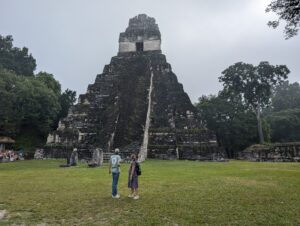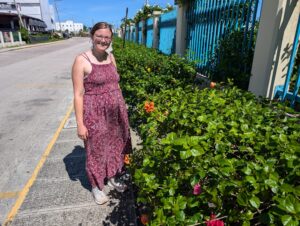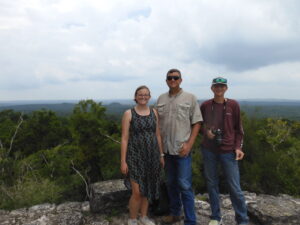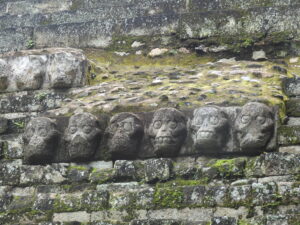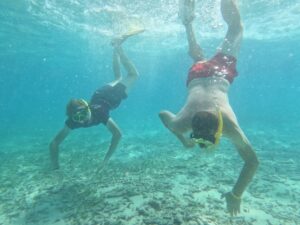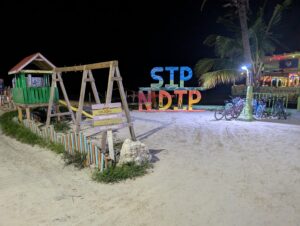Chichicastenango
Rainy Day at the Marketplace
By the time we reached Chichicastenango, it was about 5:00 p.m. We had been in contact with Juan, a local preacher, through people we know at Sunset International Bible Institute. I have noticed that any time our finding a church to visit in a foreign place relies on contacts made through Sunset, I am asked to preach. This trend continued during our visit to Chichicastenango. I don’t mind doing this. It is an interesting experience, and it takes a different approach to preaching for a congregation in America, with whom I share a language and so many cultural understandings.
Worship at the Church of Christ here happens at 3:00 p.m. on Sunday afternoon, so we had Saturday evening and Sunday morning to see the town. After services, we would have to hot foot it back toward Flores. I planned to split the 11 hour drive between Sunday evening and Monday morning. This was the stretch of trip Audrey was keen on avoiding. The rental car was due back in Flores at 10:00 a.m. Monday.
Juan met us at a gas station on the edge of town. He was a young man, apparently in his twenties. We went to a couple of the sites that tourists often visit in Chichicastenango. We visited an arch with Mayan themed artwork that had been constructed in the 1930s. Many tourists have their photos taken there. We then visited an area that I believe was part of the main central market, the reason most people visit Chichicastenango. In this area, we walked to the Iglesia de Santo Tomás. In about 1545, the Spanish built this small church atop a Mayan temple platform as was often their practice. The church itself contains 18 steps, representing the months of the Mayan calendar. People still come to burn incense sacrifices on the steps. The steps are also covered with newspaper-like confetti that Juan told us was residue from fireworks. It is otherwise a rather plain building. This church’s convent was where the oldest known written version of the Popol Vuh (the Mayan sacred story) was discovered.
Juan mentioned that we could either visit a restaurant for dinner, or if we wanted a more authentic Guatemalteco experience we could eat street food from the market. Aware that many gringos are reticent about eating local foods in places like this, he carefully mentioned that if we were concerned for our stomachs, we might be better off at a restaurant. I callously volunteered us for the street food experience without first consulting Andrew. I think Andrew wanted to try the street foods, but his stomach had been restive throughout most of the trip. When I belatedly consulted him, he seemed to be on board with the more authentic option, regardless of any potential digestive risks.
The food stand we went to had relatively few options, but most of them were new to us, so it worked out well. We began with a drink that had the consistency of horchata, but was made from helote (street corn) instead of rice. It was a warm, thick drink that I really liked. Andrew was less enthusiastic about it, though he did not seem to dislike it. To eat, I had a couple of things that looked like about half of a tamale. They were virtually all masa, though – the corn based dough portion of the tamale. Andrew had a couple of things that pretty closely resembled tostadas. I was still hungry after this, and so ordered a couple of different pupusas as we walked through other parts of the market; one filled with cheese, the other with chicharon. Andrew was not game for trying the latter.
Across from the Iglesia de Santo Tomás we saw the Capilla del Calvario, another starkly white Catholic building. This one was open and conducting a service as we walked by. Since the doors were open, we peeked in to get a look at the facility which had large slanting pillar like supports from the side walls. We opted not to intrude on the service and continued on our way. Outside, there was a long, vertical raw looking pole standing not quite straight erect. Juan informed us that on a festival day people swing from this pole. He showed us a picture of four men swirling around the pole on ropes attached to their ankles. It looked rather dangerous, and Juan confirmed that at least once, someone had fallen to the ground during this performance.
(Continued)
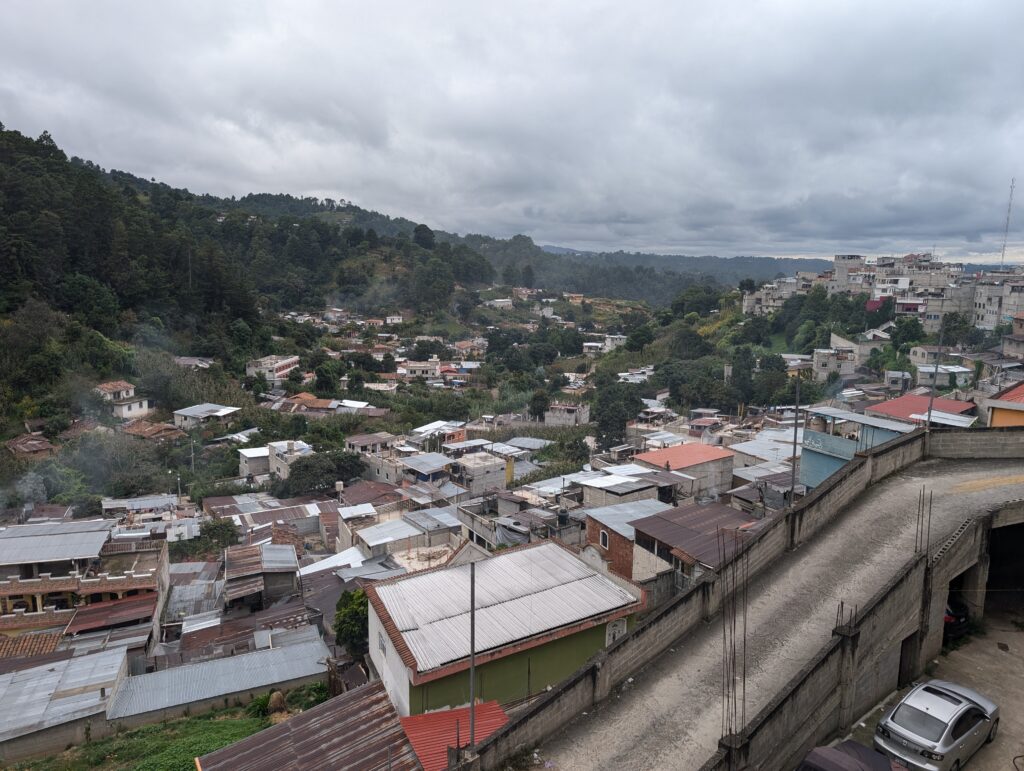
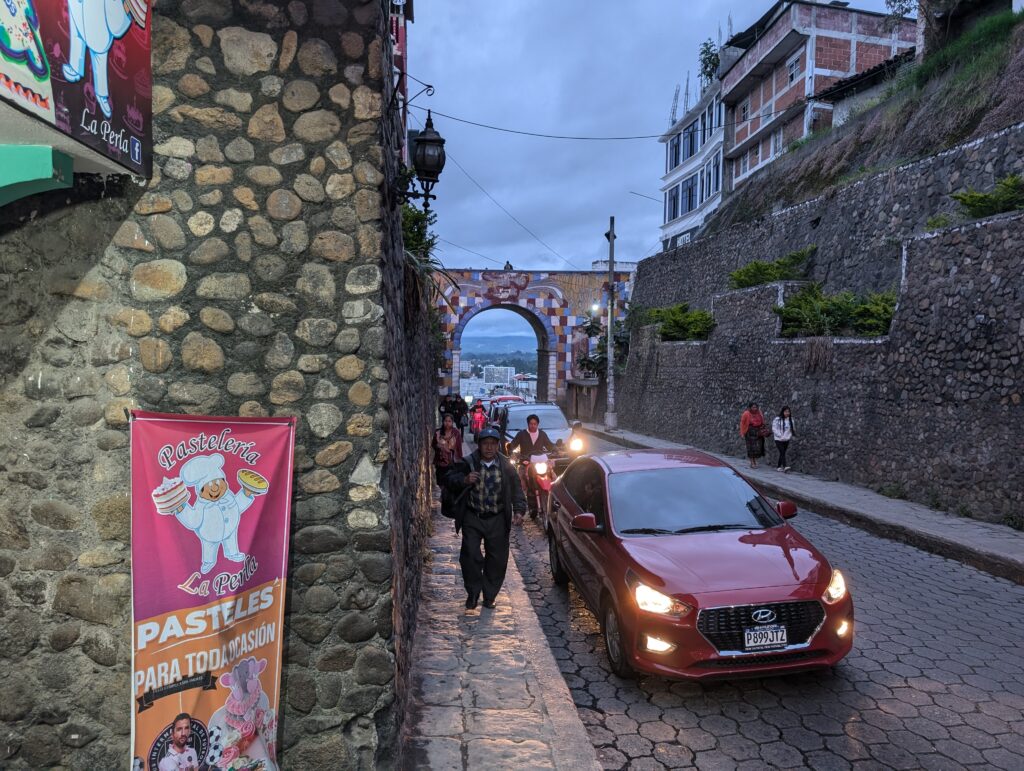

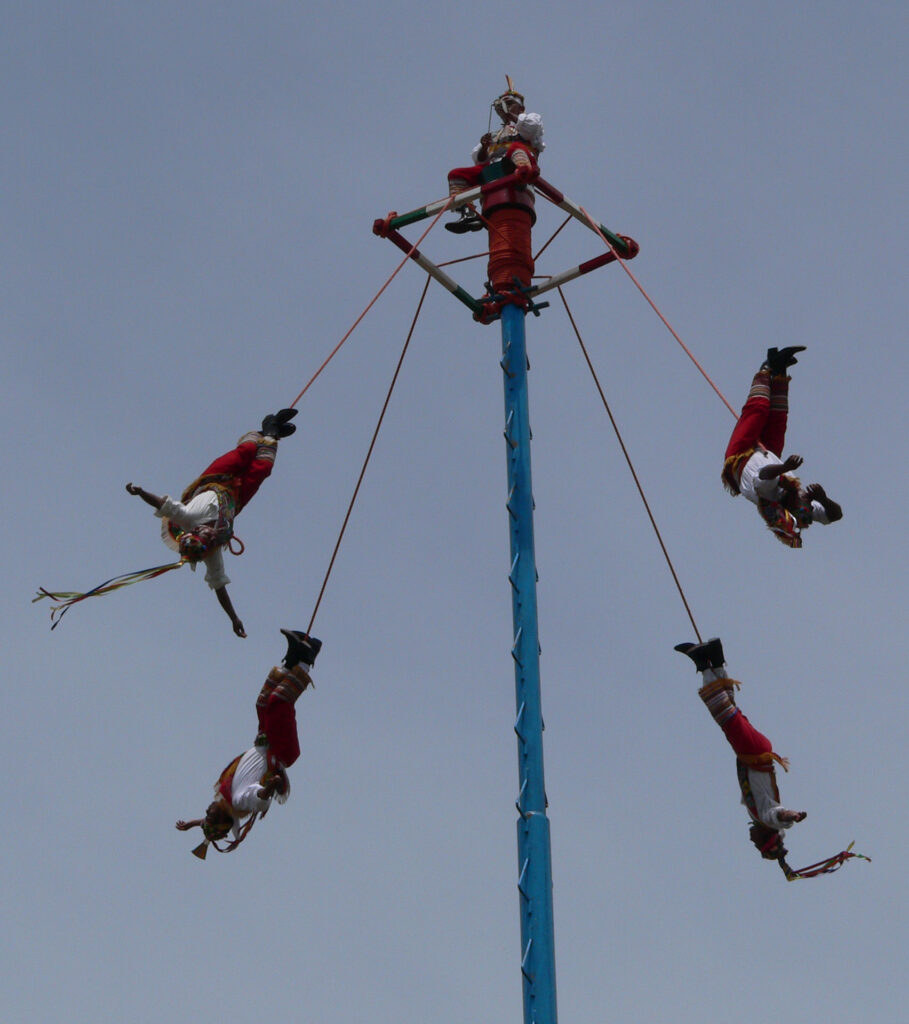
After seeing several of these local sights, Juan led us to the ASELSI compound where we would spend the night. ASELSI stands for Association for Equipping the Saints International. The abbreviation must be for the Spanish translation, because the letters don’t all work in English. ASELSI seems to be a non-denominational nonprofit organization that hosts Christian groups from America while they do service or mission work in the Quiche (pronounced “key-chay”) region of Guatemala. The fenced and gated compound had a guard and a pack of German Shepherds that were let out at night. There were two large buildings sitting among a well cared for courtyard. One was for administrative purposes, the other to house visitors.
While we arrived after dark, it was clear that this facility looked markedly different from the rest of Guatemala. It was a modern, clean, beautiful facility more like a large, luxury AirBnB than even a nice Western style hotel. There was a huge common area with couches, televisions, a large kitchen, complete with skylights and large windows overlooking the manicured courtyard. Just off of the main shared living space were several rooms filled with bunk beds and spacious bathroom and shower facilities. It seemed especially posh after spending the previous two weeks in various Central American accommodations. This made even the very nice quarters we hired in Copan Ruinas which had so impressed Audrey seem dated and a bit shabby.
We were grateful for having been directed to such a nice place, but something about it felt a little bit out of place, especially for a facility built to host people doing mission work. I cannot fairly comment on the effectiveness of ASELSI’s work. I am sure they are enabling some very nice service projects that benefit the people of this part of Guatemala. I cannot help but believe, though, that it must be hard to make meaningful connections with people if you cannot deign to experience conditions anywhere near those in which they live even as you work with and among them. There was a set of instructions sitting near the table from the last group to have visited the ASELSI facility for a week long service project. They were instructed under no circumstances to ever leave the facility or the group alone. Is Chichicastenango that dangerous? I didn’t seem so to me. There was a basket filled with oatmeal and generic Gatorades set aside for people with “sick tummies.” All of this protected by a high fence, German Shepherds, and a guard. It certainly all gave the vibe of a place where gringos come to have photos taken holding a shovel with grateful natives in the background. This feeling was reinforced by the price. I had wondered whether perhaps we were being hosted here as a benefit of volunteering to preach on Sunday. That turned out not to be the case. I did not agree to preach really expecting compensation, so I didn’t mind paying for our lodging. It did, however, end up costing over three times what I paid for our quarters in other shared facilities. It was more than three times as nice. So it wasn’t necessarily a bad deal, it just somehow seemed not quite appropriate as a mission work.
We slept well. We had planned to get an early start Sunday morning to see the market at its peak, but both Andrew and Juan (who had gone to his home for the night) overslept. It was raining anyway, so I sat and worked on my articles. We did eventually go to the market, but we did not see it at its peak. Vendors and traffic were both impeded by the rain. There was still some commerce going on, so we watched and participated in it.
One area that clearly doubled as a basketball and indoor football facility was covered with produce vendors. The produce looked cleaner and generally of better quality than those outside. I decided to grab a couple of giant carrots and a bunch of small bananas. I wasn’t really sure what the going rate was, but I was pretty sure I was supposed to negotiate. I offered amounts modestly under the original asking price, and walked away with my intended raw foods.
Andrew had spent most of his intended trip budget, and I don’t buy a lot of souvenirs anyway. As such, we didn’t buy much. I just wanted to see this market, as it was the chief reason tourists visited the town. I always enjoy people watching at markets as well. It was busy enough that you had to pay attention to where you were going. There were a lot of locals there. We also saw several European tourists, but not many Americans. At one point, I walked past a girl selling pea green colored foods of some sort that were shaped kind of like a flatter misshapen tomato. I asked what these were, and Juan told me. He said they were kind of like a sweeter potato. He said they were already cooked, so I could try one. These cost almost nothing, and I am always interested in trying new foods. It did indeed taste like a sweeter version of a potato; not a sweet potato, just a sweeter version of a regular potato. It wasn’t the best thing I’ve ever eaten, but it was palatable.
Since we weren’t really buying anything anyway, we wrapped up our visit to the market after a little over an hour. Juan wanted to take us to a special restaurant at a mirador overlooking the city for lunch. I had my suspicions about how much we would see, considering how shrouded the area was with low clouds. When we arrived, the view was indeed completely obscured, but it was a pleasant restaurant. We had our lunch on the veranda before heading to the church. Juan had intended to buy lunch, but came up a bit short, so I used my small bills to cover part of the bill, and to leave a tip.
(Continued)
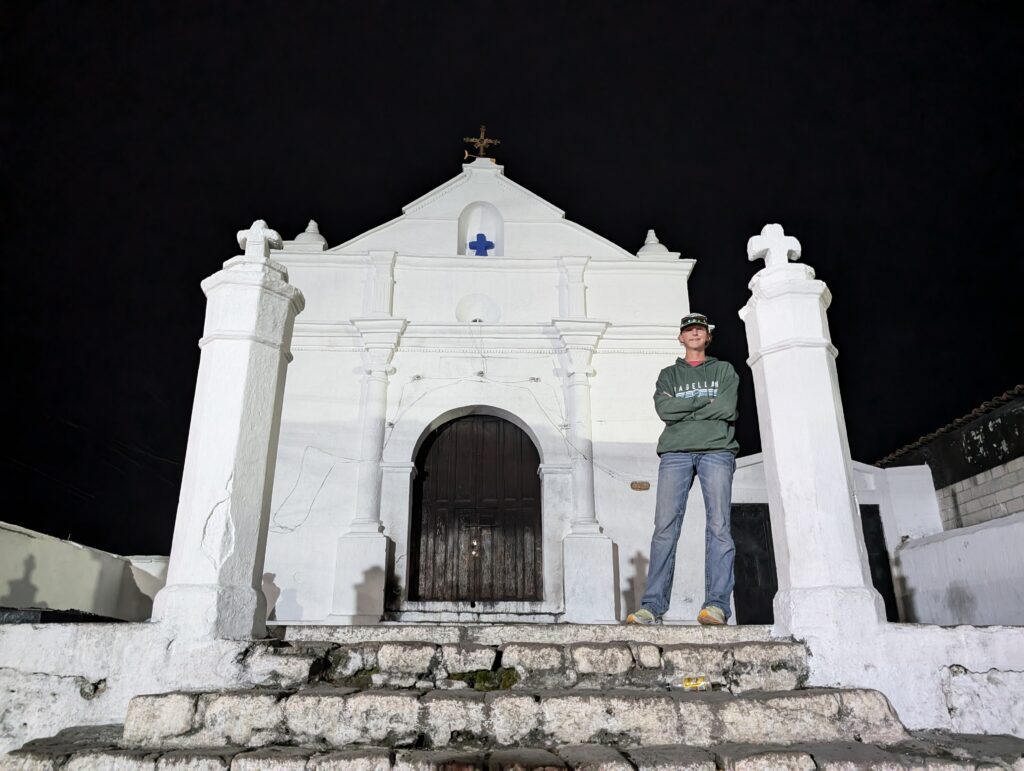
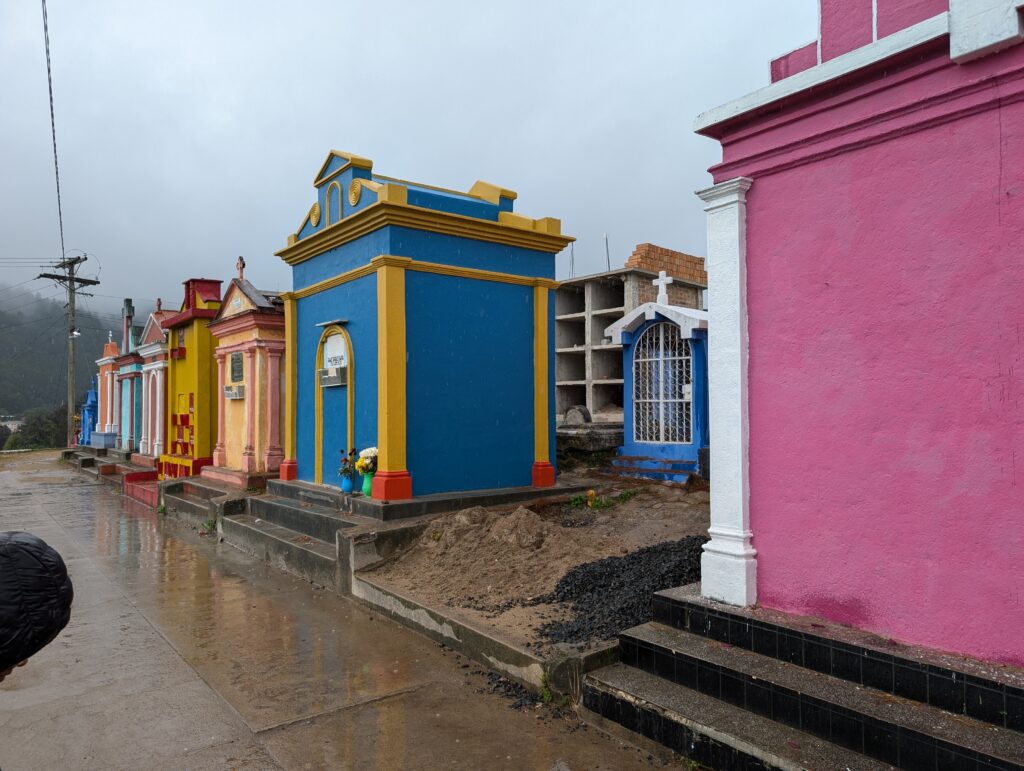
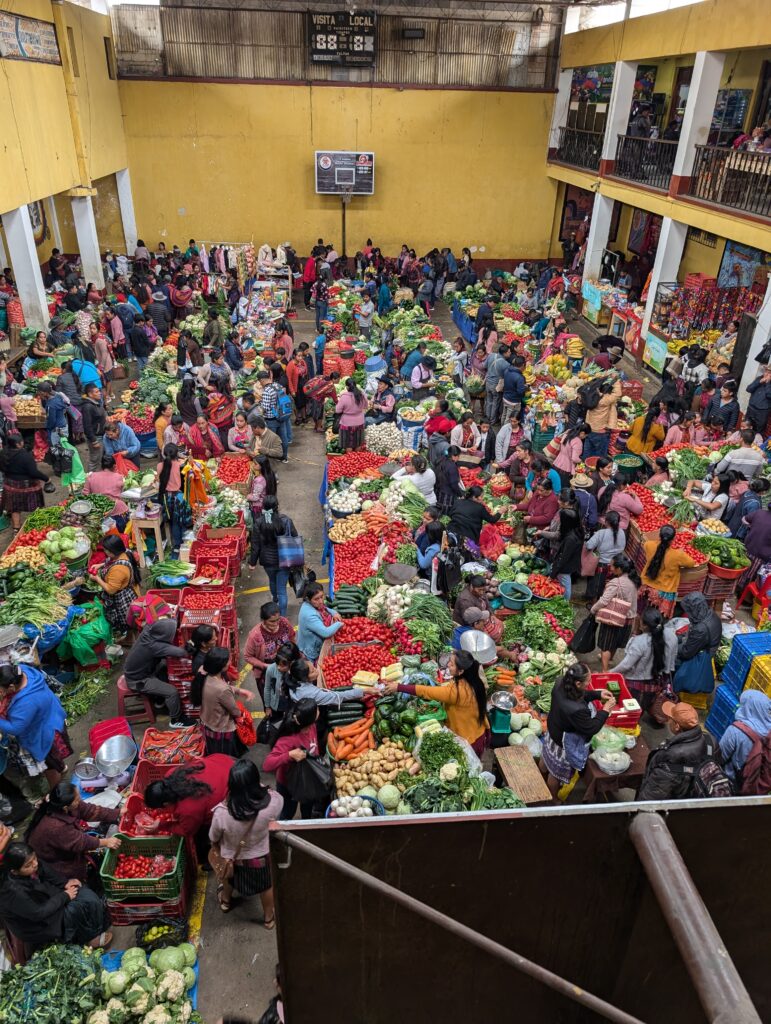
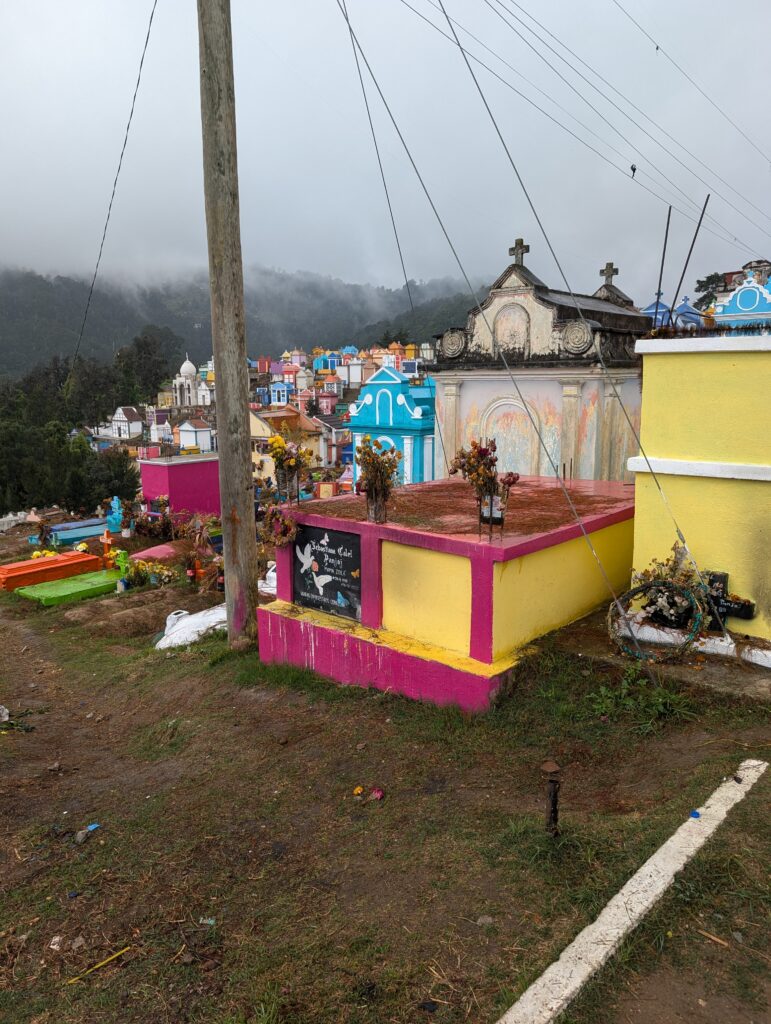
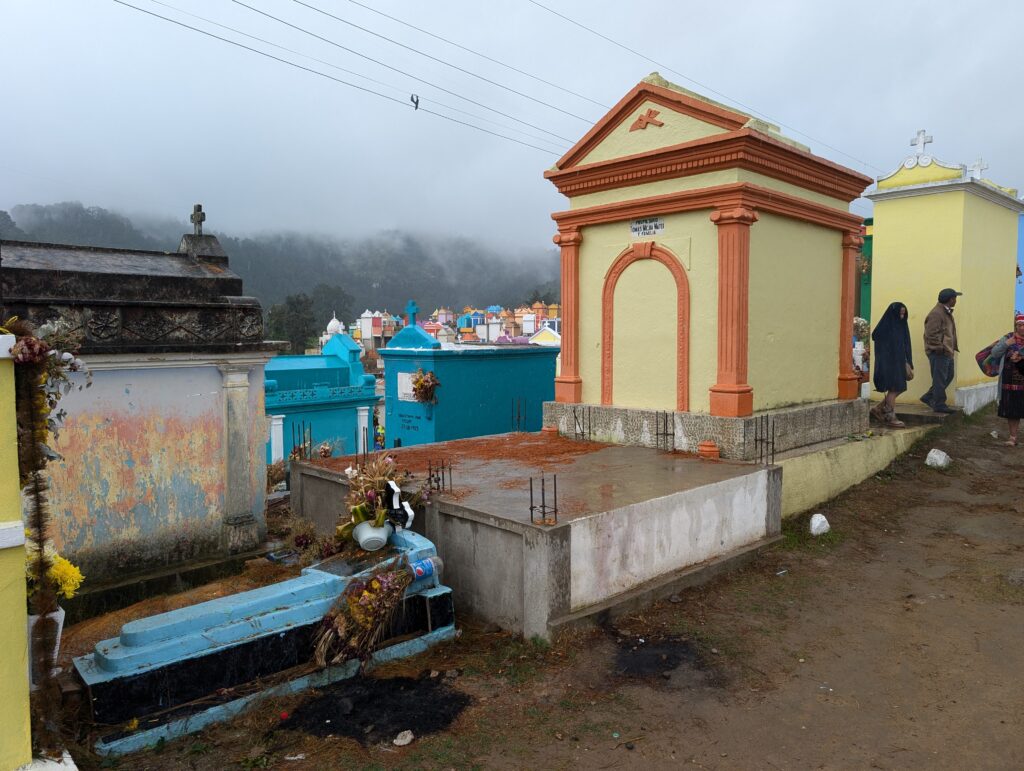
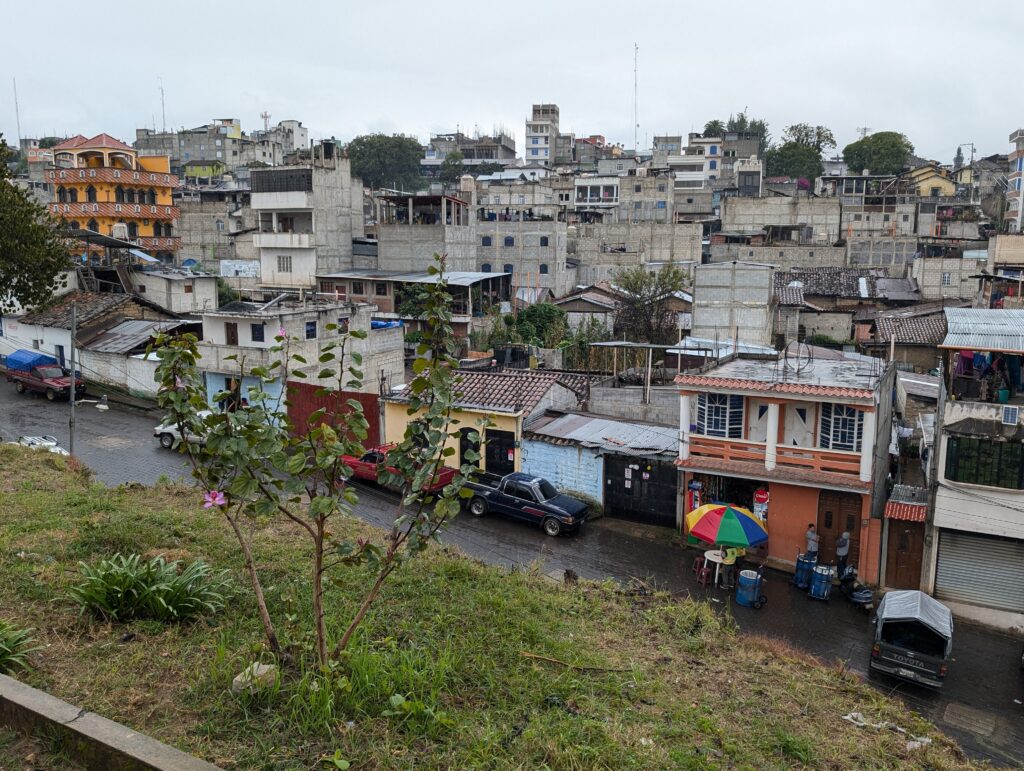
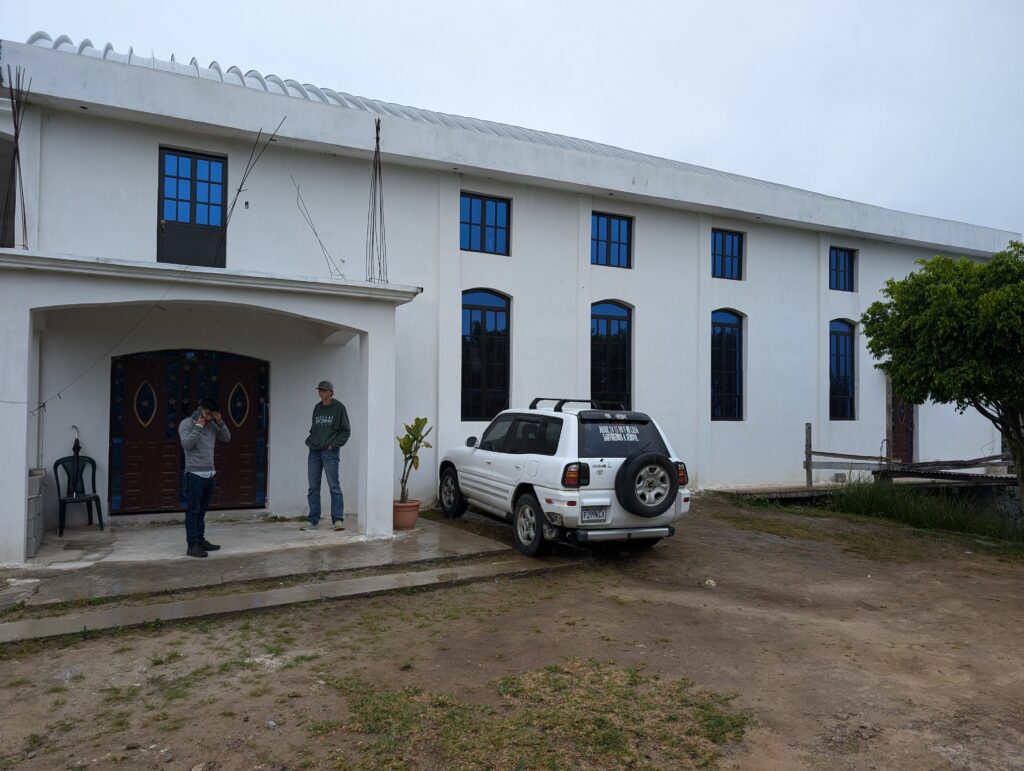
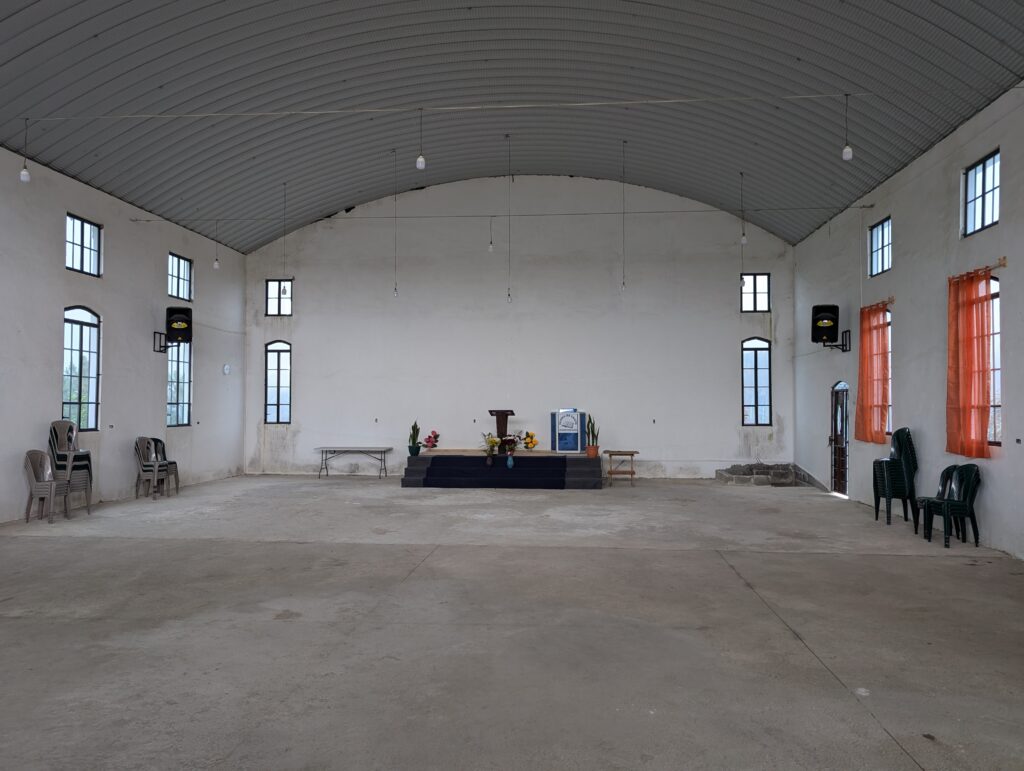
It was a long ride over a short distance to the church, as was often the case in Guatemala. Juan had discouraged us from driving to church in the rain since our car sat lower than his, and the road was unpaved and had washes in it. Retrospectively, I could have made it. But the church building was in a different direction than we would need to go to head back toward Flores, so it was just as well that we rode with him.
The Iglesia de Cristo Juan works with has just completed the exterior of a new building. It is a large facility, economically constructed of cement and block, like so many buildings in Central America. It has a partial quonset roof and straight walls. The bathrooms are in an outhouse. The floor is still cement, and the pulpit platform is constructed from two by fours. Plain as it sounds, it is all quite functional, and done as neatly and cleanly as possible. We unstacked and restacked plastic chairs at the end of the service.
There was a worship service, but no Bible Class. This was probably good, because the worship service alone topped two hours. We sang a lot of songs toward the beginning of the service. Although most of the service was in Quiche, no one has translated songs into that language, so the singing was in Spanish. We were able to recognize most of the songs and could follow along OK. Once I borrowed a Spanish language song book, it was much easier for me. The hymnals had words but not notes. They were all accompanied by a visual depiction of the motion needed by the song leader to beat the time for that time signature. The singing was robust, but apparently a little less so than on other Sundays. Juan informed us that their praise team (a group of strong singers who help carry the four harmonizing parts for those who struggle with harmonic parts) was away singing with a different church that Sunday.
As we do each week in Churches of Christ, we partook of the Lord’s Supper. Shortly thereafter, it was my turn to speak. With enough advance notice, I might have been able to translate my sermon into Spanish. I certainly couldn’t have communicated anything in Quiche. Juan had agreed to translate for me. I knew he was putting it into Quiche, because I did not recognize many of the words. Occasionally, there was a Spanish word thrown in. I got the impression pretty early on that Juan was not just translating. I would often say about half of a sentence, after which he would talk for several minutes. I suppose he was either trying to explain, or perhaps guessing where I was going with the talk. I had tried very hard to simplify statements, especially any with implications or figurative language.
I could only assume that most of what he was doing was helpful. The more I am asked to preach in foreign venues, though, the more I wonder if it is particularly effective. It is so difficult to bridge the culture gap for illustrations and jokes in the first place, and so difficult to explain nuances from scripture in other languages, that I wonder if it might be better to turn down such offers in the future. It always feels so awkward. My experience felt even more awkward when Juan hinted that I had been preaching too long, and that I should wrap it up in the next five minutes. This was pretty ironic to me, as I generally preach about 20 minutes and I certainly had been speaking a lot less than Juan in this instance. It turned out I was close to done, anyway. I had only one paragraph left. But after the translation that took another seven minutes, so I guess technically I still went over time.
Knowing we had a long way to drive that night, Juan generously offered to drive us back to the ASELSI house as soon as we got done preaching. I thought it best not to walk out on the service. As has been the case at every Latin American service we have been to, the announcements did take a very long time. Even so, I felt better about staying to the end, shaking a few hands, and helping pick up the chairs. Eventually, we made our way back to the ASELSI compound, topped off our waters, emptied our bladders, and started toward Coban at about 6:00.
Just as we were about to leave, Juan reminded me that the ASELSI house had a cost. It was Q370. Since I had used all of my small bills at the restaurant, I had only Q100 notes. Juan also did not have any small bills to make change, so I handed him Q400, and we were on our way. I was a little nervous about timing. Our hostel at Coban closed at 11:00 p.m., and the GPS suggested the drive would take over five hours. We made up some time, and arrived at the Calvario hostel to meet a very tired hostel host at 10:30. We were on track to get our rental car back on time, or at least close to it.

